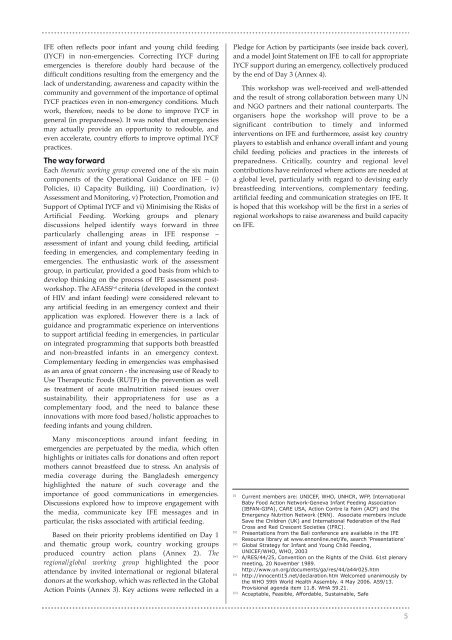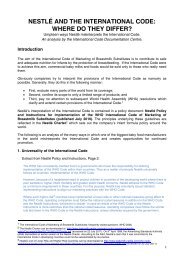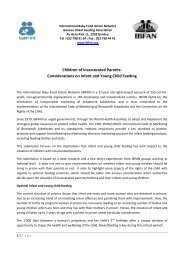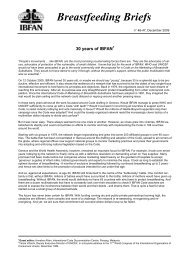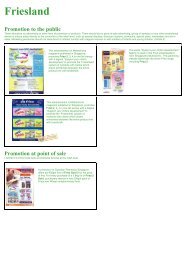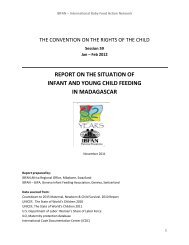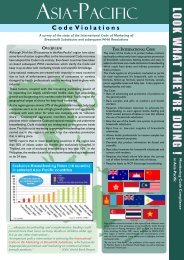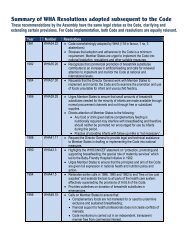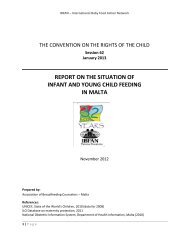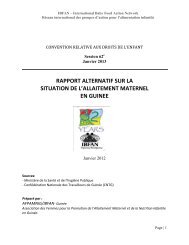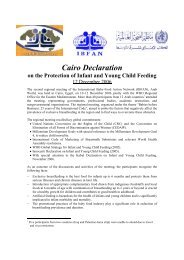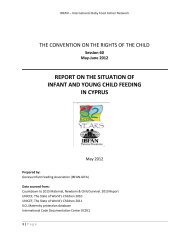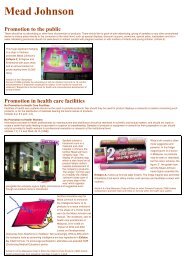Infant and young child feeding in emergencies. Making it ... - IBFAN
Infant and young child feeding in emergencies. Making it ... - IBFAN
Infant and young child feeding in emergencies. Making it ... - IBFAN
You also want an ePaper? Increase the reach of your titles
YUMPU automatically turns print PDFs into web optimized ePapers that Google loves.
IFE often reflects poor <strong>in</strong>fant <strong>and</strong> <strong>young</strong> <strong>child</strong> <strong>feed<strong>in</strong>g</strong><br />
(IYCF) <strong>in</strong> non-<strong>emergencies</strong>. Correct<strong>in</strong>g IYCF dur<strong>in</strong>g<br />
<strong>emergencies</strong> is therefore doubly hard because of the<br />
difficult cond<strong>it</strong>ions result<strong>in</strong>g from the emergency <strong>and</strong> the<br />
lack of underst<strong>and</strong><strong>in</strong>g, awareness <strong>and</strong> capac<strong>it</strong>y w<strong>it</strong>h<strong>in</strong> the<br />
commun<strong>it</strong>y <strong>and</strong> government of the importance of optimal<br />
IYCF practices even <strong>in</strong> non-emergency cond<strong>it</strong>ions. Much<br />
work, therefore, needs to be done to improve IYCF <strong>in</strong><br />
general (<strong>in</strong> preparedness). It was noted that <strong>emergencies</strong><br />
may actually provide an opportun<strong>it</strong>y to redouble, <strong>and</strong><br />
even accelerate, country efforts to improve optimal IYCF<br />
practices.<br />
The way forward<br />
Each thematic work<strong>in</strong>g group covered one of the six ma<strong>in</strong><br />
components of the Operational Guidance on IFE – (i)<br />
Policies, ii) Capac<strong>it</strong>y Build<strong>in</strong>g, iii) Coord<strong>in</strong>ation, iv)<br />
Assessment <strong>and</strong> Mon<strong>it</strong>or<strong>in</strong>g, v) Protection, Promotion <strong>and</strong><br />
Support of Optimal IYCF <strong>and</strong> vi) M<strong>in</strong>imis<strong>in</strong>g the Risks of<br />
Artificial Feed<strong>in</strong>g. Work<strong>in</strong>g groups <strong>and</strong> plenary<br />
discussions helped identify ways forward <strong>in</strong> three<br />
particularly challeng<strong>in</strong>g areas <strong>in</strong> IFE response –<br />
assessment of <strong>in</strong>fant <strong>and</strong> <strong>young</strong> <strong>child</strong> <strong>feed<strong>in</strong>g</strong>, artificial<br />
<strong>feed<strong>in</strong>g</strong> <strong>in</strong> <strong>emergencies</strong>, <strong>and</strong> complementary <strong>feed<strong>in</strong>g</strong> <strong>in</strong><br />
<strong>emergencies</strong>. The enthusiastic work of the assessment<br />
group, <strong>in</strong> particular, provided a good basis from which to<br />
develop th<strong>in</strong>k<strong>in</strong>g on the process of IFE assessment postworkshop.<br />
The AFASS [vi] cr<strong>it</strong>eria (developed <strong>in</strong> the context<br />
of HIV <strong>and</strong> <strong>in</strong>fant <strong>feed<strong>in</strong>g</strong>) were considered relevant to<br />
any artificial <strong>feed<strong>in</strong>g</strong> <strong>in</strong> an emergency context <strong>and</strong> their<br />
application was explored. However there is a lack of<br />
guidance <strong>and</strong> programmatic experience on <strong>in</strong>terventions<br />
to support artificial <strong>feed<strong>in</strong>g</strong> <strong>in</strong> <strong>emergencies</strong>, <strong>in</strong> particular<br />
on <strong>in</strong>tegrated programm<strong>in</strong>g that supports both breastfed<br />
<strong>and</strong> non-breastfed <strong>in</strong>fants <strong>in</strong> an emergency context.<br />
Complementary <strong>feed<strong>in</strong>g</strong> <strong>in</strong> <strong>emergencies</strong> was emphasised<br />
as an area of great concern - the <strong>in</strong>creas<strong>in</strong>g use of Ready to<br />
Use Therapeutic Foods (RUTF) <strong>in</strong> the prevention as well<br />
as treatment of acute malnutr<strong>it</strong>ion raised issues over<br />
susta<strong>in</strong>abil<strong>it</strong>y, their appropriateness for use as a<br />
complementary food, <strong>and</strong> the need to balance these<br />
<strong>in</strong>novations w<strong>it</strong>h more food based/holistic approaches to<br />
<strong>feed<strong>in</strong>g</strong> <strong>in</strong>fants <strong>and</strong> <strong>young</strong> <strong>child</strong>ren.<br />
Many misconceptions around <strong>in</strong>fant <strong>feed<strong>in</strong>g</strong> <strong>in</strong><br />
<strong>emergencies</strong> are perpetuated by the media, which often<br />
highlights or <strong>in</strong><strong>it</strong>iates calls for donations <strong>and</strong> often report<br />
mothers cannot breastfeed due to stress. An analysis of<br />
media coverage dur<strong>in</strong>g the Bangladesh emergency<br />
highlighted the nature of such coverage <strong>and</strong> the<br />
importance of good communications <strong>in</strong> <strong>emergencies</strong>.<br />
Discussions explored how to improve engagement w<strong>it</strong>h<br />
the media, communicate key IFE messages <strong>and</strong> <strong>in</strong><br />
particular, the risks associated w<strong>it</strong>h artificial <strong>feed<strong>in</strong>g</strong>.<br />
Based on their prior<strong>it</strong>y problems identified on Day 1<br />
<strong>and</strong> thematic group work, country work<strong>in</strong>g groups<br />
produced country action plans (Annex 2). The<br />
regional/global work<strong>in</strong>g group highlighted the poor<br />
attendance by <strong>in</strong>v<strong>it</strong>ed <strong>in</strong>ternational or regional bilateral<br />
donors at the workshop, which was reflected <strong>in</strong> the Global<br />
Action Po<strong>in</strong>ts (Annex 3). Key actions were reflected <strong>in</strong> a<br />
Pledge for Action by participants (see <strong>in</strong>side back cover),<br />
<strong>and</strong> a model Jo<strong>in</strong>t Statement on IFE to call for appropriate<br />
IYCF support dur<strong>in</strong>g an emergency, collectively produced<br />
by the end of Day 3 (Annex 4).<br />
This workshop was well-received <strong>and</strong> well-attended<br />
<strong>and</strong> the result of strong collaboration between many UN<br />
<strong>and</strong> NGO partners <strong>and</strong> their national counterparts. The<br />
organisers hope the workshop will prove to be a<br />
significant contribution to timely <strong>and</strong> <strong>in</strong>formed<br />
<strong>in</strong>terventions on IFE <strong>and</strong> furthermore, assist key country<br />
players to establish <strong>and</strong> enhance overall <strong>in</strong>fant <strong>and</strong> <strong>young</strong><br />
<strong>child</strong> <strong>feed<strong>in</strong>g</strong> policies <strong>and</strong> practices <strong>in</strong> the <strong>in</strong>terests of<br />
preparedness. Cr<strong>it</strong>ically, country <strong>and</strong> regional level<br />
contributions have re<strong>in</strong>forced where actions are needed at<br />
a global level, particularly w<strong>it</strong>h regard to devis<strong>in</strong>g early<br />
breast<strong>feed<strong>in</strong>g</strong> <strong>in</strong>terventions, complementary <strong>feed<strong>in</strong>g</strong>,<br />
artificial <strong>feed<strong>in</strong>g</strong> <strong>and</strong> communication strategies on IFE. It<br />
is hoped that this workshop will be the first <strong>in</strong> a series of<br />
regional workshops to raise awareness <strong>and</strong> build capac<strong>it</strong>y<br />
on IFE.<br />
[i]<br />
Current members are: UNICEF, WHO, UNHCR, WFP, International<br />
Baby Food Action Network-Geneva <strong>Infant</strong> Feed<strong>in</strong>g Association<br />
(<strong>IBFAN</strong>-GIFA), CARE USA, Action Contre la Faim (ACF) <strong>and</strong> the<br />
Emergency Nutr<strong>it</strong>ion Network (ENN). Associate members <strong>in</strong>clude<br />
Save the Children (UK) <strong>and</strong> International Federation of the Red<br />
Cross <strong>and</strong> Red Crescent Societies (IFRC).<br />
[ii]<br />
Presentations from the Bali conference are available <strong>in</strong> the IFE<br />
Resource library at www.ennonl<strong>in</strong>e.net/ife, search ‘Presentations’<br />
[iii]<br />
Global Strategy for <strong>Infant</strong> <strong>and</strong> Young Child Feed<strong>in</strong>g,<br />
UNICEF/WHO, WHO, 2003<br />
[iv]<br />
A/RES/44/25, Convention on the Rights of the Child. 61st plenary<br />
meet<strong>in</strong>g, 20 November 1989.<br />
http://www.un.org/documents/ga/res/44/a44r025.htm<br />
[v]<br />
http://<strong>in</strong>nocenti15.net/declaration.htm Welcomed unanimously by<br />
the WHO 59th World Health Assembly. 4 May 2006. A59/13.<br />
Provisional agenda <strong>it</strong>em 11.8. WHA 59.21.<br />
[vi]<br />
Acceptable, Feasible, Affordable, Susta<strong>in</strong>able, Safe<br />
5


